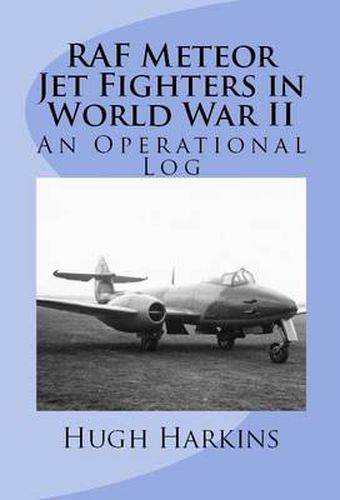RAF Meteor Jet Fighter in World War II: An Operational Log
Hugh Harkins

RAF Meteor Jet Fighter in World War II: An Operational Log
Hugh Harkins
Gloster Meteor - The advent of the gas-turbine engine pioneered in the late 1930’s by Frank Whittle in Britain and Germany’s Dr Hans von Ohain, and its subsequent development into operational jet-propulsion units led to the introduction of a new breed of combat aircraft in the last year of World War II. While Germany developed, built and flew many jet powered aircraft during the war, with several of these subsequently entering operational service, only a handful of allied jet designs actually flew before the war’s end. Of these, only the Gloster Meteor twin-jet fighter actually entered service; No.616 Squadron becoming the first jet powered squadron in the world to be declared operational. In many respects, 616Squadron gained this accolade on paper only, as some German Units were operating jet powered aircraft in contested air defence zones prior to the Meteor being declared operational. Flying their first operational sorties against V-1 Flying Bombs on 27 July 1944, the Meteor was at the time being operated on an ad hoc basis, as a direct response to the V-1 attacks against southern Britain. The Squadron did not fully relinquish its Spitfire VII’s until 13 August 1944, the date on which the last operational Spitfire mission was flown. The Meteor I was flown operational against the V-1 from late July 1944 until early September that year, following which it entered an intensive period of training through February 1945, by which time the Squadron had been transferred to the 2nd Tactical Air Force for operations on continental Europe supporting the allied armies advancing towards the German hinterland. A handful of aircraft began operating from Belgium from early February 1945, albeit in a non-operational role. The rest of the Squadron, which had been temporarily transferred back to RAF Fighter Command, commenced flying Anti-V-1 operations from early March 1945, until the 19th of that month, after which it reverted back to 2nd Tactical Air Force, flying out to Belgium on the 31st of the Month. The Squadron commenced operational missions as part of 2nd Tactical Air Force on 1 April, flying air defence and reconnaissance/ground attack sorties until the war in Europe ended, flying its last operational sorties on the 4 May 1945. By this time 504 Squadron was on the strength of Fighter Command, with several other squadrons commencing conversion to the Meteor III before World War II ended. Within weeks of the war’s end the Meteor IV, which had flown on 15 August, captured with Word Speed Record with an average speed of 606 mph. This volume covers the development of British jet aircraft and the operational service of the aircraft from summer 1944, when the aircraft were employed against V-1 flying bombs until late 1945, including the aircrafts service with 2nd Tactical Air Force supporting the allied armies during the final advance into Germany.
This item is not currently in-stock. It can be ordered online and is expected to ship in approx 2 weeks
Our stock data is updated periodically, and availability may change throughout the day for in-demand items. Please call the relevant shop for the most current stock information. Prices are subject to change without notice.
Sign in or become a Readings Member to add this title to a wishlist.


